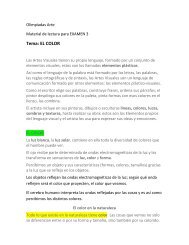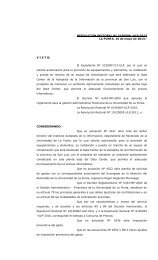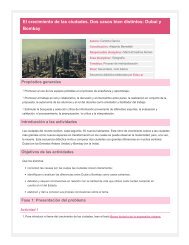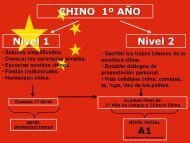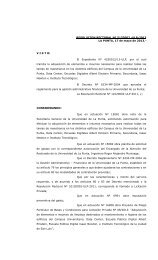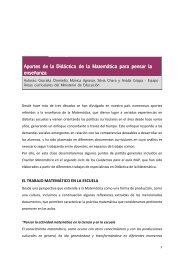e-Book PDF - Universidad de La Punta (ULP)
e-Book PDF - Universidad de La Punta (ULP)
e-Book PDF - Universidad de La Punta (ULP)
Create successful ePaper yourself
Turn your PDF publications into a flip-book with our unique Google optimized e-Paper software.
3.4 Ajuste Fino (Fine-Tuning)<br />
Cada estación se analizó en forma individual, bajando<br />
la potencia <strong>de</strong> transmisión al mínimo <strong>de</strong> forma <strong>de</strong> no<br />
computar la interferencia intrasistema, generada por<br />
las otras estaciones bases.<br />
<strong>La</strong> cobertura fue medida en sitio, lo que permitió ajustar<br />
el planeamiento agregando estaciones <strong>de</strong> alturas<br />
reducidas para lograr penetración <strong>de</strong>l tipo “microcelda”,<br />
con alcances reducidos sobre las sombras <strong>de</strong><br />
la cobertura inicial. Esto significa que la asignación <strong>de</strong><br />
canales <strong>de</strong> cada estación es susceptible <strong>de</strong> revisión<br />
en la medida que se agreguen nuevos sitios.<br />
<strong>La</strong>s áreas <strong>de</strong> cobertura previstas se han contrastado<br />
con mediciones realizadas en “drive test” en diferentes<br />
sitios <strong>de</strong> cada una <strong>de</strong> las localida<strong>de</strong>s. Para esto se<br />
ha utilizado software apropiado sobre un plano georeferenciado<br />
mostrando la intensidad <strong>de</strong> señal recibida<br />
y el ancho <strong>de</strong> banda transmitido.<br />
Para los “drive test” se han tomado sitios representativos<br />
<strong>de</strong> diferentes zonas <strong>de</strong> las ciuda<strong>de</strong>s. <strong>La</strong>s mediciones<br />
se realizaron en área urbana céntrica y suburbana.<br />
<strong>La</strong> cobertura se probó directamente con la notebook<br />
enlazando a la estación base asociada.<br />
<strong>La</strong> cobertura se probó en exterior y a nivel <strong>de</strong> suelo,<br />
por lo que se espera tener la misma performance<br />
<strong>de</strong>ntro <strong>de</strong> los hogares, en los ambientes que lin<strong>de</strong>n<br />
con el exterior. Se espera que las notebooks que operen<br />
cerca <strong>de</strong> una ventana reciban una buena señal en<br />
el rango <strong>de</strong> distancias hasta los 250 m <strong>de</strong> la estación.<br />
<strong>La</strong>s coberturas circulares previstas pue<strong>de</strong>n tener<br />
formas diferentes en función <strong>de</strong> las obstrucciones<br />
alre<strong>de</strong>dor <strong>de</strong> la estación. <strong>La</strong> separación entre las estaciones<br />
instaladas es tal que en las áreas a distancias<br />
mayores a los 400 m se solapan coberturas <strong>de</strong> estaciones<br />
adyacentes, por lo que pue<strong>de</strong>n lograrse línea<br />
<strong>de</strong> vista <strong>de</strong>spejada con uno u otro equipo.<br />
62 |<br />
The foreseen coverage areas have been contrasted with “drive test”<br />
measurements, at different sites of each of the localities. To do<br />
so, appropriate software was used on a geo-referenced plan that<br />
showed the signal intensity that was received and the bandwidth<br />
transmitted.<br />
For the “drive test” representative places of different zones of the cities<br />
were consi<strong>de</strong>red. The measurements were ma<strong>de</strong> in urban and suburban<br />
areas. The coverage was tested directly using the computer linked<br />
to the associated base station.<br />
The coverage was tested outdoors and at ground level, reason by<br />
which the same performance is expected at homes, and in open environments.<br />
It was expected that notebooks that worked near a window<br />
would receive a good signal in a range of up to 250 m from the station.<br />
The planned circular coverage may have different shapes <strong>de</strong>pending<br />
on the obstructions surrounding the station. The separation among<br />
the installed stations is such that in areas that are at a distance larger<br />
than 400 m, adjacent stations coverage overlaps, and “line of sight” is<br />
obtained with one <strong>de</strong>vice or the other.<br />
Elevated level coverage evaluations were performed, complementing the<br />
ground level ones, in or<strong>de</strong>r to adjust the coverage requirements if necessary.<br />
In those cases where there are shadow areas, two strategies can be<br />
used:<br />
1. In the case there is a strategic interest building (school, library,<br />
public offices) that were left out of the coverage area, a CPE or<br />
a WiFi receptor antenna could be set un in the outsi<strong>de</strong>, and then<br />
perform the wired LAN access to the <strong>de</strong>vice.



